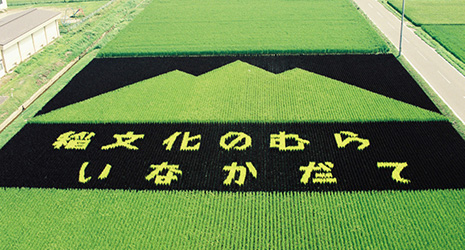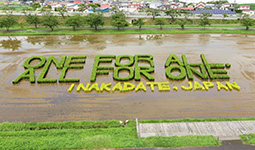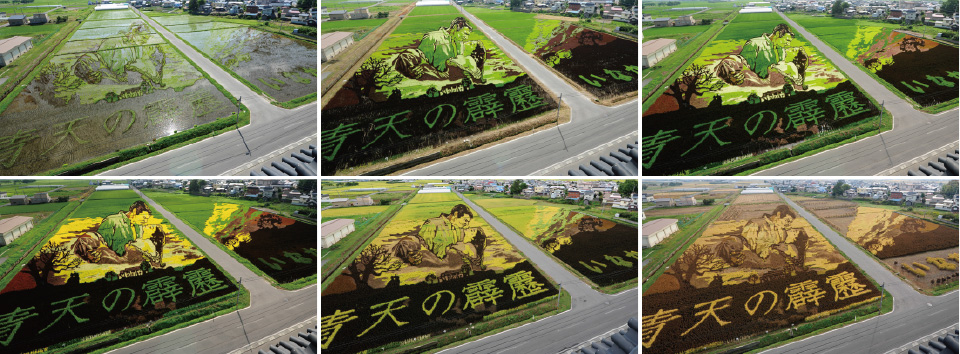INDEX
- English
- 日本語

Early rice paddy art in Inakadate Village, 1994 - English
- 日本語

Momo Taro (2017)

“ONE FOR ALL, ALL FOR ONE” (2020)
November 2020
Rice Paddy Art

The thriving agricultural village of Inakadate in Aomori Prefecture is the location of an unusual event in which rice paddies serve as canvases for enormous works of nature-made art.

In spring, the mirror-like paddies filled with water reflect the blue of the sky. In early summer, there is the radiant green of the rice plants, already growing vigorously since planting in spring. The paddies in autumn have a golden sparkle as the tops of the plants droop under the weight of the rice grains before harvesting. The appearance of rice paddies changes over the year, conveying the arrival of the seasons and delighting the eyes.
Recently, rice paddy art events, in which pictures are drawn using the different and changing colors of rice plants as “paints” and rice paddies as “canvases,” have spread across Japan, attracting many visitors.
The birthplace of rice paddy art is Inakadate Village in Aomori Prefecture. In 1981, evidence of rice production roughly 2,100 years ago was found in Inakadate Village, which is located in the middle of the Tsugaru plains. The area is covered with snow throughout the winter, and the village attracted attention at the time as the northernmost place for rice production in Japan. Blessed with productive land, the village has managed to harvest the largest amount of rice per area in Japan time after time.
Drawing on its rice-growing history, Inakadate Village offered a rice-producing experience as part of classes at the elementary school, using the same rice plant that was cultivated in ancient times. This ancient rice is different from the rice plant cultivated across Japan today, with some of its leaves being purple or yellow. From this color difference, the village office had an idea to draw Japanese characters and pictures in the paddies using the plants’ different colors, and held the first “exhibition” in 1993.
For the first few years they created simple artworks such as messages and a depiction of Mount Iwaki, a symbol of Aomori Prefecture. Gradually they started to take on the challenge of creating more complex patterns, and for the 11th event in 2003 created the Mona Lisa. However, when viewed from above, their Mona Lisa looked a little chubby. To fix this, a draft was created that corrected the perspective, and using computer modeling, a method was established to drive piles into the rice paddy according to the plan, planting rice plants in the appropriate sections. Using this method, it became possible to create increasingly elaborate pictures and realistic rice paddy art was born.
The high level of reproduction can be proved by the request for the creation of rice paddy art for movie advertising by Disney in 2015, and in the same year stunning rice paddy art was also created for Star Wars: The Force Awakens. News agencies picked up the story, and the following year the village appeared in several Japanese movies and TV shows. About 350,000 people came to visit the village, which has a population of just 8,000, to view the art.

However, as this is art made from natural processes, there are elements that cannot be controlled. According to Suzuki Toru, a member of staff in the Inakadate Village Tourism Planning Section, “In recent years, the color of the rice plant leaves has changed as the temperatures in summer have increased, and this had led to cases where parts of characters or pictures couldn’t be drawn and are missing.”
The best time to see the rice paddy art of Inakadate Village is from the middle of July until the middle of August when the rice plants grow tightly together. Some of the art is set up so that visitors can see changes in the picture from the emergence of ears of rice grains and changes in leaf colors later on.
Suzuki says, “Thanks to the rice paddy art, the name of this small village has come to be known even overseas. Using rice paddy art as an opportunity, I hope we can come up with ways in the future for visitors to enjoy the village’s specialties: our nature, rice, apples and strawberries.”
In 2020, all planting experience tours and viewings were canceled due to COVID-19, but the message “ONE FOR ALL, ALL FOR ONE” was etched into the rice paddies. Without a doubt, the rice paddy art of Inakadate Village, with its long history of rice production, will also continue long into the future.


